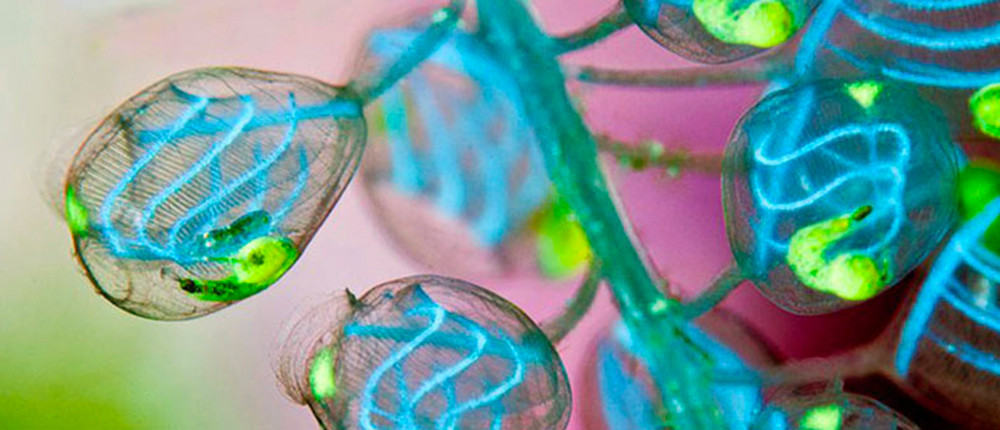Wakatobi’s Colorful Sea Squirts
A closer look at tunicates, one of the most overlooked reef dwellers
Duck below the surface on any coral reef around Wakatobi and you will immediately be immersed in a sea of color and life. Brightly decorated fish sporting intricate and intriguing patterns flash by, while cunningly camouflaged critters hide in plain sight among multi-hued corals and sponges. Soon, you’re likely to run across a cluster of diaphanous tubes or an oblong-shaped bulb sporting a mouth-like opening that pulses gently, as if puckering in anticipation of a kiss. You’ve just found a tunicate, aka sea squirt, a name derived for these animal’s tendency to squirt water from their mouth-like openings when brought to the surface.
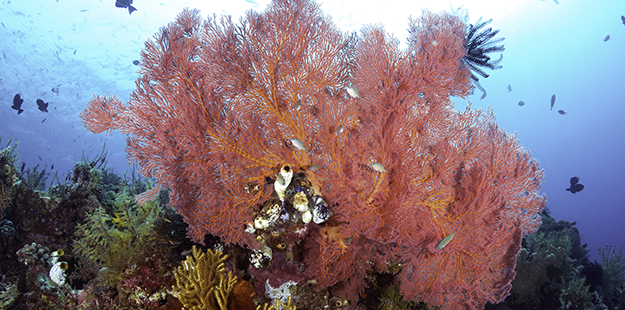
We find hundreds of varieties of tunicates at Wakatobi, some larger than a human fist, like the cluster at the base of this red sea fan. Photo by Walt Stearns
While tunicates are among the most common invertebrates in the ocean, with more than 3,000 known species occupying every niche from Arctic waters to tropical reefs, they are also quite remarkable little creatures. Some varieties are free swimming, and drift across the open ocean with the currents, but many more live stationary lives. At Wakatobi, you’ll find hundreds of these stay-at-home varieties, some the size of a human fist, and living alone, others as small as a pea, clustered with hundreds of its kind. Some adhere closely to cover, while others rise on elongated stalks that further create the impression of a flower bulb that is about to blossom.

Once it locates a suitable bit of real estate, such as this white, sea fan, the tunicate moves in headfirst and attaches itself. Photo by Paula Butler
A stationary life
Once you’ve found a tunicate on a Wakatobi dive site, you’ll have no problem locating it a second time, as these animals are literally glued to the reef. Like sponges, barnacles, and a variety of mollusks such as oysters and clams, tunicates are filter feeders, but the similarities end there. A biologist would tell you that tunicates are a bit higher up the evolutionary ladder. Though lacking a backbone, they are just one rung removed from vertebrates. They possess a spinal chord during their larval stage, and later develop complex organs including a two-chambered heart.
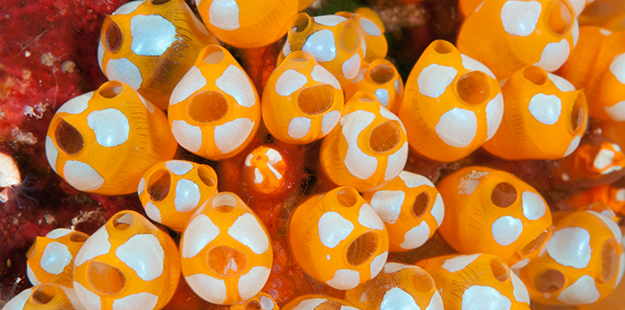
Tunicates have an enveloping skin-like outer tunic, which appears delicate, but is actually quite resilient due to a cellulose compound in their tissues–the same stuff that stiffens plants and trees. Photo by Alan Saben
Tunicates take their common name from their enveloping, tunic-like skins. These coverings may appear delicate, but are actually quite resilient, as tunicates are one of the only animals that have cellulose compounds in their tissues–the same stuff that stiffens plants and trees. Just underneath this outer covering are bands of muscles that surround an interior cavity.
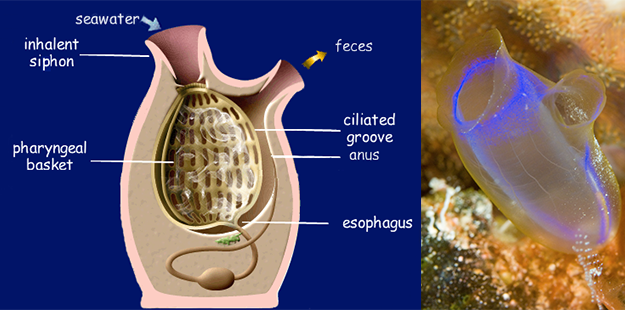
The tunicate takes in water through a mouth opening at its front end, uses a basket-like organ to strain out small food particles, then expels waste and water through a second orifice. Photo by Rob Darmanin
As the muscles pulse, they create a pumping motion, bringing in water through a mouth opening at the front end of the tunic. Inside, a basket-like organ strains out small food particles, then water and waste are expelled through a second orifice. By contracting and expanding, a tunicate is able to pump several hundred liters of water through its body each day.
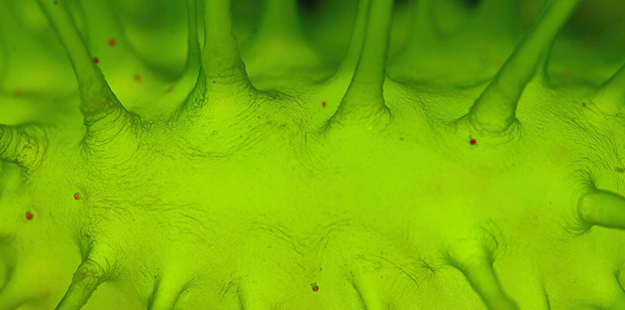
Looking like an alien landscape, inside the tunicate is a basket-like organ that strains out small food particles, then water and waste are expelled through a second orifice. Photo by Richard Smith
A tunicate tadpole has special glands in its head that secrete a powerful adhesive. Once it locates a suitable bit of real estate, it moves in headfirst and attaches itself. The tail is reabsorbed into the body, and the rest of the animal begins an internal shift, with the “mouth” opening appearing as the exterior tunic forms, and vital organs shifting towards the end attached to the reef. Mature tunicates have a life span a year or so, though some species may live up to three years. To deter would-be predators, many tunicates develop internal toxins that render their flesh unpalatable. Certain bottom dwellers such as sea stars, flatworms and nudibranchs don’t seem to mind the taste, and will make a meal of an otherwise defenseless tunicate.
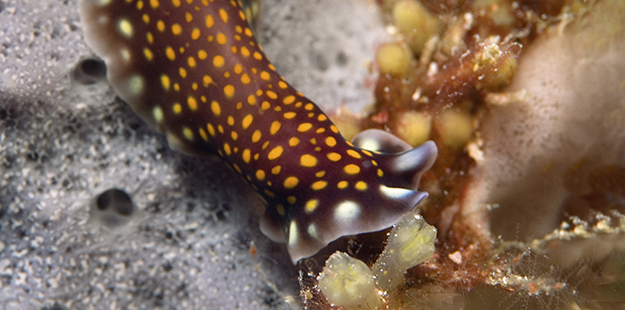
Many tunicates develop internal toxins that render their flesh unpalatable, yet certain bottom dwellers such as sea stars, nudibranchs, and flatworms (seen here) don’t seem to mind the taste. Photo by Mark Snyder
Many shapes and sizes
The tunicates you’ll find on the reefs of Wakatobi come in a variety of shades, sizes and shapes. Some might be mistaken for sponges, but if you look close, you’ll notice that the outer skin of a tunicate will seem slick, possibly even shiny, while the surface of a sponge is duller and more pitted. Some sponges may also have openings that resemble a tunicate’s mouth and waste orifices, but if this mouth-like opening doesn’t open and close, it’s probably not a tunicate.

Tunicates make interesting photographic subjects, especially when the body is translucent and its details can be accentuated with strobe lighting. Photo by Wayne MacWilliams
Sometimes, there’s no mistaking a tunicate for anything else, especially when the body is translucent or set on a stalk. These are the animals that make interesting photographic subjects. Any camera system capable of close focus work will do, just take your time to get in close without disturbing the reef. You’ll get the best results if you move in and shoot level rather than down on the subject, either putting blue water in the background, or reducing the depth of field to downplay the background and accentuate the details of the tunicate. Often, the most dramatic results can be achieved when using some type of side or slight back lighting that enhances the animal’s translucent qualities. This could be an off-camera strobe or backlighting from the sun.
With so many remarkable and intriguing creatures to see on the reefs of Wakatobi, it would be easy to overlook tunicates entirely. But once you start noticing these sometimes unobtrusive creatures, and learn a bit about their nature and physiology, you’ll see them in a new light.
See these siphons of the sea, and the multitude of other marine life found in our waters on your next dive or snorkeling holiday at Wakatobi. Contact us at office@wakatobi.com or complete a quick trip inquiry at wakatobi.com.
More about tunicates here.
Visit us on facebook.


